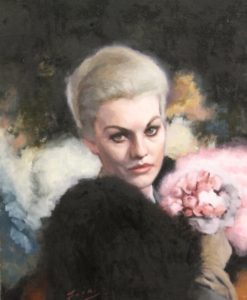By Page H. Gifford
Correspondent
At the monthly meeting of the Fluvanna Art Association artist Bryan Trent Fair discussed his passion for portrait painting. Many of the artists were impressed with his work as they listened to him talk about his artistic journey.
A Buckingham County native, born in Richmond, Fair started drawing during his early years and took art classes in high school. The love of drawing the human face and figure were more appealing than landscapes, which the majority of FAA artists prefer to paint. Many novice artists are afraid to draw figures, which appear more challenging to them than landscape.
This attraction to the human form and delving deeper into the essence of his subject was uppermost in his mind when he chose to study graphic art at Virginia Commonwealth University in the 1980s.
“The idea of sitting in a cubby somewhere and drawing fashion illustrations appealed to me but then computers came along and changed everything and what I did became obsolete,” he said. After graduating, he was an adjunct professor, teaching fashion design and figure drawing. He had no further interest in graphic arts and the calling to be a portrait painter became strong and he followed his heart’s desire to northern Virginia and the Torpedo Factory, where he studied with renowned artist Rob Liberace and Danny Dawson.
“I learned about skin tones and how to identify color, including flesh tones, using bright saturated colors, no earth tones, like bright greens, purples and, golds for darker skin,” he said. To pay the bills and support his art, he did administrative work but devoted every spare moment to taking workshops and promising himself he would learn to master and utilize what he had learned.
His art eventually fell by the wayside as work took over his life, but remained on the fringes. But it wouldn’t be long before it became front and center in his life. Recalling his favorite artist, John Singer Sargent, who inspired him, he moved to Los Angeles and studied with well-known California figurative painters, including Jeremy Lipking and Morgan Weistling. These artists are known for their realism.
While living in California, he exhibited his work in galleries in West Hollywood, North Hollywood and throughout the San Fernando Valley. His award-winning work has been used by independent filmmakers for film projects as well as television. A classic film buff, his paintings of actors from the golden age of Hollywood and beyond feature the influence of Sargent with a soft, loose and impressionistic style.
“My Hollywood pieces were a favorite at regular shows held at a local gallery in L.A.,” he said. While studying art in California, Fair learned a different color palette with muted, low-key and muddy colors. He said edges were also important.
 “These artists were all about edges, everything does not have to be resolved and have a hard line.” He showed the members that by simply blending, objects fade softly into the background, avoiding the hard lines.
“These artists were all about edges, everything does not have to be resolved and have a hard line.” He showed the members that by simply blending, objects fade softly into the background, avoiding the hard lines.
After living for 13 in California, Fair returned home to Buckingham with his partner to care for his mother. He is currently working as an executive assistant at Sentara Martha Jefferson Hospital. He continues to work in art with commissions and exhibiting throughout Virginia.
He discussed his process with interested members. Painting mainly in oil, Fair favors clay board with gesso to give it tooth and hold the brush strokes. He likes a limited palette which adds to the overall unity of the painting.
“Always start with a good drawing, a solid foundation, the bones,” he said. “Painting from life is important and using a photograph is acceptable but knowing what is lifelike helps shape the subject in reality.
“Remember, not everything has to be rendered, loosen the edges and smooth them out. This is an area for looking at turning forms, looking at which direction something is turning, the light and the edges. Watch for the transitions in the face. Always soften the eyes and mouth and never use harsh straight lines when drawing or painting children, it ages them.”
A member commented that his work resembled a photograph.
“Saying an artist’s work looks like a photograph is not a compliment,” he said in a lighthearted way but explained that his goal is to capture the inner essence of the subject, particularly in the eyes and mouth in a single, quiet moment through his slightly impressionistic and realistic style.
“It is my intention to represent my subjects in a way that is evocative and resonant with the viewer.”




